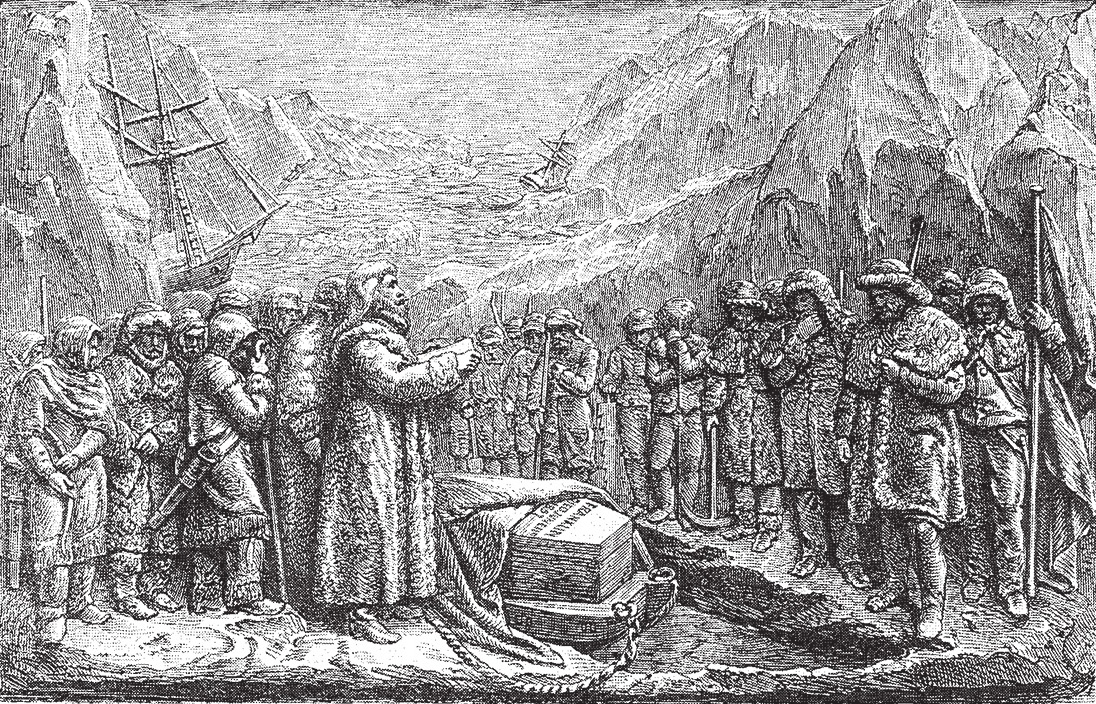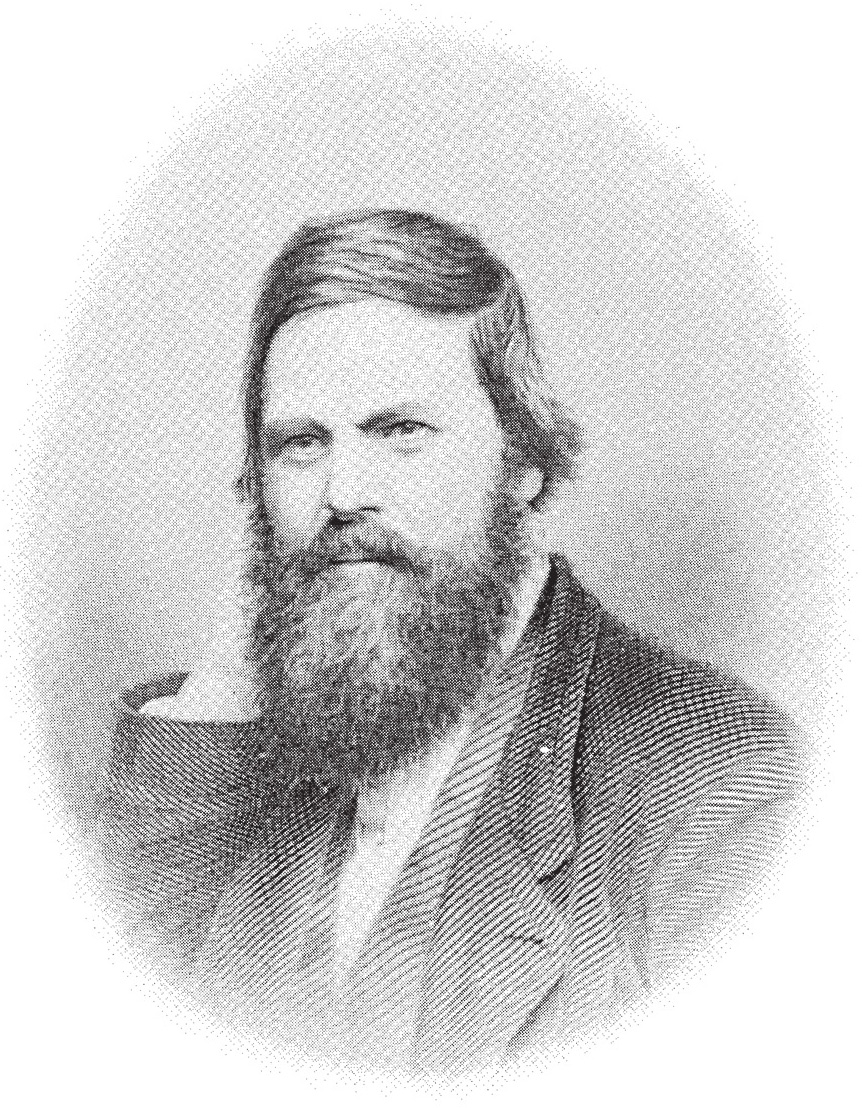Frozen in Time (8 page)

This picture, of dying seamen shambling along, dragging sledges loaded down with the detritus of Victorian England, is the enduring image of the Franklin expedition disaster. Reviewing the evidence in 1881, M'Clintock concluded that surviving members of Franklin's expedition:
⦠were far gone with scurvy when they landed; and the change from the conï¬ned lower decks, and inaction, to extreme exposure in an Arctic temperature, combined with intensely hard sledging labour, would almost immediately mature even incipient scurvy. The hospital tent within 80 miles [130 km] of the spot where their march commenced is, I think, conclusive proof of this. The
Investigator
[McClure's search expedition] is almost the only ship which has ever similarly spent three winters in the ice. Although she had only three deaths in all that time, yet a careful medical examination revealed the fact that only 4 out of a total of 64 on board were not more or less affected by scurvy. Such is the usual results of limitation to salted or preserved provisions, unrelieved by fresh animal or vegetable food. It is evident that disease, not starvation, carried off the earliest and by far the largest number of Franklin's companions, those martyrs to the cause of geographical discovery.
Even among his own sledging parties, M'Clintock observed, “scurvy advanced with rapid strides.” Hobson, who had carried tinned pemmican for food, “suffered very severely in health,” ultimately having to be dragged back on the sledge. Wrote M'Clintock of Hobson's plight: “How strongly this bears upon the last sad march of [Franklin's] lost crews!” Years later, Hobson was asked: “Can you give⦠any opinion as to the cause why scurvy broke out with you?” His answer was, “I can scarcely say that scurvy did break out with us. I said that the men were debilitated, that they lost stamina. There was no cause that I know of, except the fact of not being able to get really fresh meat and fresh vegetables.”

Franklin's men lie dying beside the boat with which they had planned to ascend the Back River, King William Island.
Oil painting by W.T. Smith

Burial in mid-winter, from M'Clintock's voyage aboard the
Fox.
The success of their voyage brought both honour and fame to M'Clintock and Hobson, as well as some solace to Lady Franklin. She now knew the exact date of Franklin's death and that he had died aboard-ship long before the ï¬nal, gruesome events on King William Island, thus preserving his reputation. What is more, he had died close enough to his objective to have justiï¬ed at least a moral claim to the prize: Discoverer of the Northwest Passage. M'Clintock had produced, it was popularly decided, “melancholy evidence of their success.” Sherard Osborn, who had commanded a ship in an earlier search, captured the public mood when he wrote of Franklin:
Oh, mourn him not! unless you can point to a more honourable end or a nobler grave. Like another Moses, he fell when his work was accomplished, with the long object of his life in view.

The burial of Franklin.
Depicted on the monument erected to him at Waterloo Place, London.
In Toronto, the
Globe
echoed:
Sir John, we now know, sleeps his last sleep by the shores of those icy seas whose barriers he in vain essayed to overcome. He died, as British seamen love to die, at the post of duty. Surrounded, let us hope, by his gallant officers, who, while he lived, would minister to his every want, and when dead would bear him to his cold and lonely tomb in some rocky bay, with saddened hearts and tear-bedewed eyes.
Finally, on 15 October 1859, the
Illustrated London News
attempted to recapture the emotions felt by Franklin's sailors near Victory Point in their ï¬nal desperate struggle to survive:
Awfully impressing must it have been to Lieutenant Hobson, and subsequently Captain M'Clintock, when they thus stood upon the intrenched scene where their gallant countrymen had, eleven years previously, prepared themselves for that last terrible struggle for life and home. Who shall tell how they struggled, how they hoped against hope, how the fainting few who reached Cape Herschel threw themselves on their knees and thanked their God that, if it so pleased Him that England and home should never be reached! He had granted to them the glory of securing to their dear country the honour they had sought for herâthe discovery of the Northwest Passage.
In their last ï¬nal march, the crews of the
Erebus
and
Terror
had indeed discovered the Northwest Passage. But by the time they walked along the shores of Simpson Strait, the triumph must have been a hollow one, for all around them was despair.
Franklin and his crews entered the Arctic with their primary goal the completion of the passage. Although geographically there is no single passage, and on a map it is possible to plot a myriad of routes around and through the clusters of islands that make up the Arctic archipelago, in reality, until the advent of ice-breakers, ice conditions narrowed the possibilities to only a few choices. By 1845, when Franklin sailed, much of the mainland coast of North America had been charted by overland explorers questing for a navigable passage, and when the ship-based explorations up to that point are added to the map of the Arctic, it becomes apparent that only a relatively short distance, in the King William Island region, remained uncharted.
In their ï¬rst season in the Arctic, Franklin's ships sailed up Wellington Channel to 77ËN latitude where they were turned back either by ice or the lateness of the season. The expedition then travelled south to Barrow Strait by a previously unexplored channel between Bathurst and Cornwallis islands. Wrote M'Clintock: “Seldom has such an amount of success been accorded to an Arctic navigator in a single season, and when the
Erebus
and
Terror
were secured at Beechey Island for the coming winter of 1845â46, the results of their ï¬rst year's labour must have been most cheering.” When the sailing season of 1846 began with the break-up of ice in Barrow Strait and in Erebus Bay (their winter harbour off Beechey Island), the two ships sailed roughly south and west, ending beset in the ice off the northwest coast of King William Island in September 1846. What route the ships took to reach this point is still a matter of conjecture, though it is likely the
Erebus
and
Terror
travelled through Peel Sound and what is now Franklin Strait between Somerset and Prince of Wales islands. Franklin believed this route would eventually lead him to parts of the mainland coastline he had explored two decades earlier. His maps told him that, in the King William Island area, he had to complete the stretch along the west side of what was then called King William's Land (a distance M'Clintock estimated at 90 miles/145 kmâbut, in fact, was actually 62 miles/100 km) to be credited with completing the charting of a Northwest Passage.
The northern extent of this unknown gap was a low point of land on the northwest coast of King William Island, visited by James Clark Ross from the east in the late spring of 1830. Ross had named the location Victory Point. The southern extent was to be found at Cape John Herschel on the south coast of King William Island. In 1839, Peter Warren Dease and Thomas Simpson explored along the mainland coast; moving eastward along the coast to Boothia Peninsula, they eventually turned back to the south coast of King William Island, exploring the island until they reached Cape John Herschel, where they built a large cairn. From this point they crossed back to the mainland and retraced their route to the west, a route which itself had been extended over time to Bering Strait, the western entrance to the passage.
Curiously, perhaps tragically, both Ross in 1830 and Dease and Simpson in 1839 suggested that the area they had explored was an extension of the mainlandâa bulge of land connected directly to the southwestern part of Boothia Peninsula. It is very likely that Franklin, armed with the maps, descriptions and opinions of these earlier explorers as well as his own theories on the geography of the region, believed he had no choice in sailing direction when he eventually encountered Cape Felix, the northern tip of King William Island. Thinking that a route to the east of this point would lead to a dead end, he turned his ships to the southwest, directly into the continuously replenished pack-ice that grinds down the length of McClintock Channel from the northwest. The power and persistence of this ploughing train of ice cannot be overestimated; the northwest coast of King William Island bears the scars as proof. This ice mass does not always clear during the short summers and a lethal trap awaited the two ships, a trap made all the more cruel with the realization that the route along the eastern coast of the island regularly clears during the summer. It was only during their ï¬nal doomed march that the surviving men from the
Erebus
and
Terror
completed the gapâand the Northwest Passage. In the words of searcher Sir John Richardson, “they forged the last link of the Northwest Passage with their lives.”
M'Clintock's discoveries on King William Island thus provided an outline of the expedition's last days. And with this new information, the ï¬nal clamour for answers to the Franklin mystery died down, even though it was apparent that many questions remained. As the
Illustrated London News
was to explain on 1 January 1881: “[M'Clintock's] search was necessarily a hasty and partial one, as the snow lay thick on the ground, and the parties had to return to their vessel before the disruption of the ice in summer.”
In the end, the impetus for continuing to probe the Franklin disaster came not so much from the British but from two colourful Americans, who were without any Arctic experience when they each began their separate searches.

Charles Francis Hall.
Charles Francis Hall, a Cincinnati, Ohio, businessman who became interested in the Arctic following the disappearance of Franklin's expedition, decided in 1859 to conduct a search of his own. Hall argued before potential backers that Franklin survivors might still be alive among the Inuit; besides, the shores of King William Island needed to be searched during the summer for more clues as to the expedition's last days. After a failed ï¬rst attempt to reach King William Island, Hall returned again in July 1864, ï¬nally reaching its southern coast in May 1869. Here, Hall noted Inuit accounts of cannibalism among Franklin's starving crews. He also recorded his anger at learning from the Inuit that, while several native families had provided an officer thought to be Crozier and a group of his men with some seal meat, the Inuit had then left, ignoring pleas for further aid. Forgetting to add that the Inuit themselves only managed to survive at subsistence level, Hall wrote: